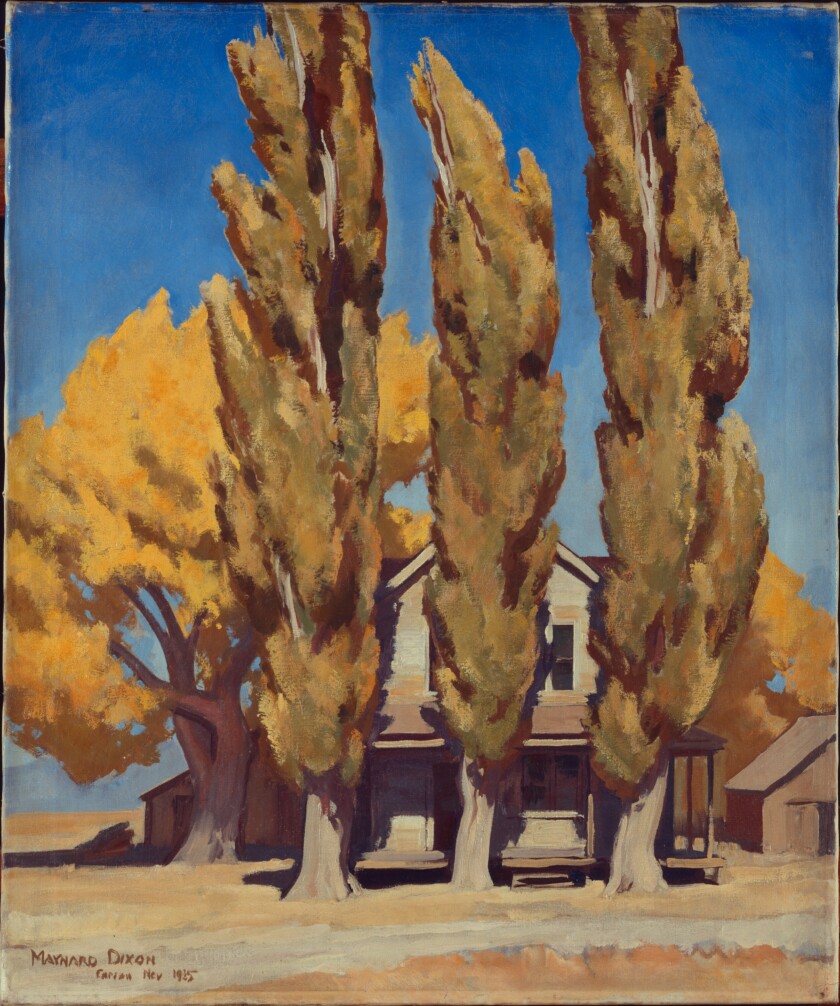Searching for Love with the Art of Dixon
The exhibition Maynard Dixon: Searching for a Home explores the many ways Dixon tried to capture the American West using paintbrush and pen. Presenting over seventy paintings, together with the artist's poetry, this show details Maynard Dixon's lifelong quest for a home. In this date activity, you'll explore the five sections in this exhibition with your partner. When finished, return to the front desk to receive a souvenir!
Enter the gallery and turn right.
The Land

Read aloud the poem on the wall next to the painting 'High in the Morning.'
- How does this painting capture the essence of the poem?
- Is there a place in nature that elicits a similar emotional response from you?
Walk into the alcove to your right.
Marveling at the enduring mesas and silent canyon walls, Dixon noticed nature's kinship with the resilience of the human spirit. In fact, his landscapes so strongly reflect humanity, they are said to convey a range of human characteristics.
- Each of you select and examine a landscape in this room that resonates with you.
- First, share why you chose that work. Then, select three characteristics from the list below, that you feel best describe the scene. Feel free to add to this list!
- Examples: calm, strong, gritty, serene, bold, adventurous, humble, energetic, quiet, imposing, powerful, peaceful, daring, gentle, etc.
- Describe how these characteristics are reflected in the painting.
- Think of someone in your life who embodies those traits. Share with your partner!
Exit the alcove and find the paintings depicting Native American Peoples.
Indigenous Life Through Dixon's Eyes

During the time Dixon spent traveling among the Navajo and Hopi, indigenous peoples were facing cultural oppression. In one sense, Dixon's paintings celebrate their cultures and prove his affection and respect for the people of the Southwest. Yet some might argue that Dixon romanticized the West and showed a world unaffected by westward expansion.
As you explore this part of the gallery, pay attention to the themes outlined below. Find paintings in which each of these themes are present and discuss how they are communicated!
- Examples: culture, pride, belonging, home, etc.
Together, choose and look closely at one painting, then complete the following sentences:
- Examples: "I see", "I think", "I feel", "I wonder,", etc.
Continue on into gallery space dedicated to painting of homes.
Other People's Houses

Judging from the regularity with which he painted others' homes, Dixon envied those who had grown roots into the arid desert earth. He painted dwellings of all kinds, this expressing his administration for people of all backgrounds. For Dixon, the western home, homestead, and farmhouse carried strong symbolic associations as an eternal refuge; a peaceful corral where he hoped to return at day's end.
Peruse the dwellings in this portion of the gallery and choose two scenes to compare and contract:
- How are they similar? How are they different?
- Think about your own home; How does it compare to the homes painted here?
- How can dwellings be so different, yet all be considered "home"?
Which scene do you feel bests captures your idea of "home"?
- Where in this world do you feel most at home and why?
In the adjacent portion of the gallery, you'll encounter several portraits.
The People

Dixon's paintings portray his genuine affection for the diverse people who forged the vibrant society of the American West.
Painting a portrait can be a lengthy process. Choose one portrait and imagine Dixon seated with his subject while painting and speaking with them.
- What do you imagine they might have talked about?
- If you were present in the conversation, what would you have wanted to ask the subject?
What information can you glean about the subjects from thier portraits?
- What has Dixon captured about these individuals, beyond their environment, belongings, and even their trade?
- If you had your portrait painted, what would you want to convey about yourself and how would you go about it (outfit,, props, body language, background, etc.)? Why are those things important to you?
Proceed into the final area of the exhibition. You should see the exit from this room.
Forgotten Men

Unlike Dixon's subject in his previous paintings, the figures that populate his Depression-Era works are not identified.
- How does their anonymity affect the meaning of these paintings?
- What social issue did Dixon portray in these paintings? To what extent are these concerns still relevant in today's society and perhaps even in your own life?
Finally, pause at the poetry wall before you leave the exhibition. Either compose a poem of your own, or discuss the following question:
- Which resonates with you more powerfully: written or visual art? Why?
Thank you for visiting the Brigham Young University Museum of Art. Don't forget to return to the front desk at receive a gift!